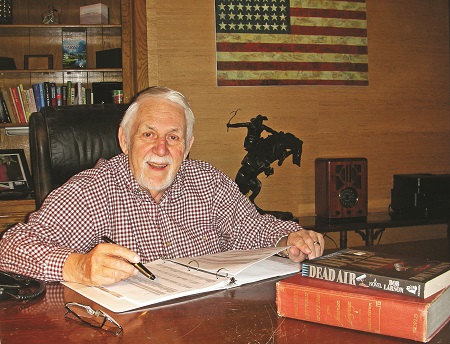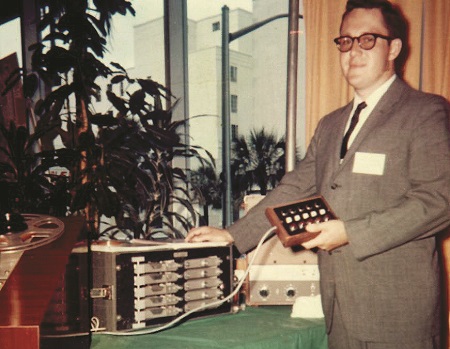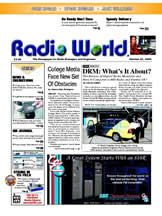Dick
Witkovski is a Texas gentleman with
a rich history in the radio
business.
 |
Dick
Witkovski, still in the
office at age 77.
Credit: Photo by Mark
Persons |
Born
a natural salesman in 1937, he was
bored after two years of book-taught
sales training in college. His
approach was to make a customer feel
comfortable before asking for a
sale. Dick caught the attention of,
and was subsequently hired by, James
B. Tharpe, president of Visual
Electronics in New York in 1957.
Visual was a manufacturer and rep
for some 70 major vendors serving
broadcasting worldwide. Since Dick
was the only bachelor out of 42
salesmen at the company, he was
selected to go abroad and stay there
until the task was finished. It was
good broadcasting education.
When Dick started in the equipment
business, stations used disc cutters
to record commercials on vinyl
records, then they moved on to Ampex
and Magnecord reel-to-reel tape
recorders.
Visual sent Dick to Disneyland to
develop a relationship with Lou
Mackenzie, the person who provided
some 500 channels of audio for sound
effects in the park. Visual adapted
the Mackenzie 5CPB Five-Channel
Selective Program Repeater for top
40 radio stations to do tight news
and production.
It
was an early tape machine that
featured "instant" audio. It
revolutionized the way locally
produced sound effects and
commercials were put over the air.
Dick traveled from New York to L.A.
on that project. The photo above
shows Dick demonstrating a Mackenzie
machine at a Florida Broadcasters
meeting in 1960.
When the Fidelipac audio tape
cartridge was introduced, Spotmaster
built cart machines to handle them.
Visual became the largest Spotmaster
dealer.
DOOR-TO-DOOR SALESMAN
Since there was no Internet at the
time, Dick simply got in his car and
drove station to station in ten
states showing off and selling this
miracle product for radio. He fondly
remembers meeting with many famous
broadcast company owners and their
program directors along the way.
After Visual developed a large U.S.
customer base, the company decided
to send Dick packing with cartridge
machines to the BBC in England,
where they were doing station breaks
and IDs in 20 languages using
reel-to-reel tape machines.
Operators had to rewind and cue each
one frequently.
Dick said, "You should have seen
their eyes when they saw Spotmasters
run network IDs. No manual cue time
was required."
He
left England with an order for five
recorders and 30 playback machines.
In recounting the tale, Dick said,
"I then knew the broadcast industry
was where I belonged."
He
continued on to France, Spain, and
Switzerland, taking orders from more
government-owned stations. Private
ownership of stations was not
allowed there until the mid-1970s.
There was a major turning point in
Dick's life in 1962 when he married
his dream girl, Bonnie Sue. Some 52
years later they are still together.
After his Visual days, Dick started
what became Besco Internacional, a
world leader in pre-owned AM, FM and
shortwave transmitters. As
technology changed, the market was
flooded with used transmitters that
needed to find new homes. His
company has been doing that for the
last 40 years.
Dick realized that FM was where the
future of radio was headed when FM
radios became available in
automobiles. FM stations started
with horizontal transmitting
antennas. Car radios had vertical
receiving antennas. It didn�t take
long to see that dual or circular
polarized antennas were the
improvement required to give maximum
coverage for FM.
 |
Witkovski demonstrates the
Mackenzie machine.
Credit: Mark Persons |
"FUTURE MONEY"
Many back then thought that FM stood
for "Free Music," but Dick said it
was known as "Future Money" by
industry analysts.
In
1973, Dick, his wife and youngest
son went to Puerto Rico to scope out
FM broadcasting in the Caribbean.
Much to their surprise, Puerto Rico,
the Virgin Islands and the Dominican
Republic were just learning about
FM; a one-month visit became a
three-year adventure.
The family moved to Aguadilla,
Puerto Rico, where the pre-owned
transmitter business began to
blossom. Dick became the exclusive
dealer for the CSI transmitter line.
They were made in Boynton Beach,
Fla. Dick became a close friend of
pilot Bob Fleming, who would fly CSI
equipment to Puerto Rico on
three-hour flights from Miami for
$100 per skid.
With FM becoming profitable in
Puerto Rico, Dick sold new CSI units
to 44 stations and took their used
units on trade, then in turn sold
them to stations 90 miles west, in
the Dominican Republic. After three
years, he sold approximately 80 new
and pre-owned transmitters, made
hundreds of new friends and drove
16,000 miles each year on an island
only 125 miles long by 30 miles
wide. Dick hosted some 85
houseguests and played golf on the
nicest courses in the Caribbean with
customers and friends.
The Canadian government allowed AM
stations to shut off their AMs in
trade for an FM channels. This
opened an avenue for Dick to
purchase well-maintained AM
transmitters. In total, Dick bought
and sold about 45 in the 5 to 50 kW
range. Most went to Central and
South America, in order to do
charitable work for missionaries on
limited budgets.
In
order to locate even more
transmitters, Dick wrote and printed
ID Magazine. It was sent out to
12,300 stations in America, Canada
and Mexico and was a success for
three years until the Internet came
along. Then Dick became his own best
customer after observing profits
being made on FM with the ability to
buy rim-shot stations, which were
then upgraded to serve much larger
markets.
He
has owned, operated and upgraded
some 34 FM stations in the past 12
years. Dick relocated six
in Dallas-Fort Worth taking them
from 6 kW to 100 kW on towers as
tall as 2,034 feet. Dick currently
owns KOME(FM) in Meridian, Texas;
KZRC(FM) in Bennington, Okla.;
KMAD(AM) Madill, Okla.; KKHA(FM)
Markham, Texas; and KBYC(FM)-Markham,
Texas.
The FCC has always encouraged better
use of the spectrum, and Dick did
his part to help them accomplish the
task.
After attending 27 NAB National
Shows as an exhibitor, Dick attended
four more as a broadcaster. It was
much easier being a customer than an
exhibitor, he said.
That brings us to the rest of the
story, as Paul Harvey would say. One
of the most interesting parts of
Dick's 58-year broadcast career was
being involved in the development of
commercial "pirate" radio stations.
In a later article, we will relate
Dick's Radio Nord and Radio Caroline
stories.
Mark Persons, CPBE, has over 45
years of experience. He has written
numerous articles for industry
publications over the years. His
website is
www.mwpersons.com. |



